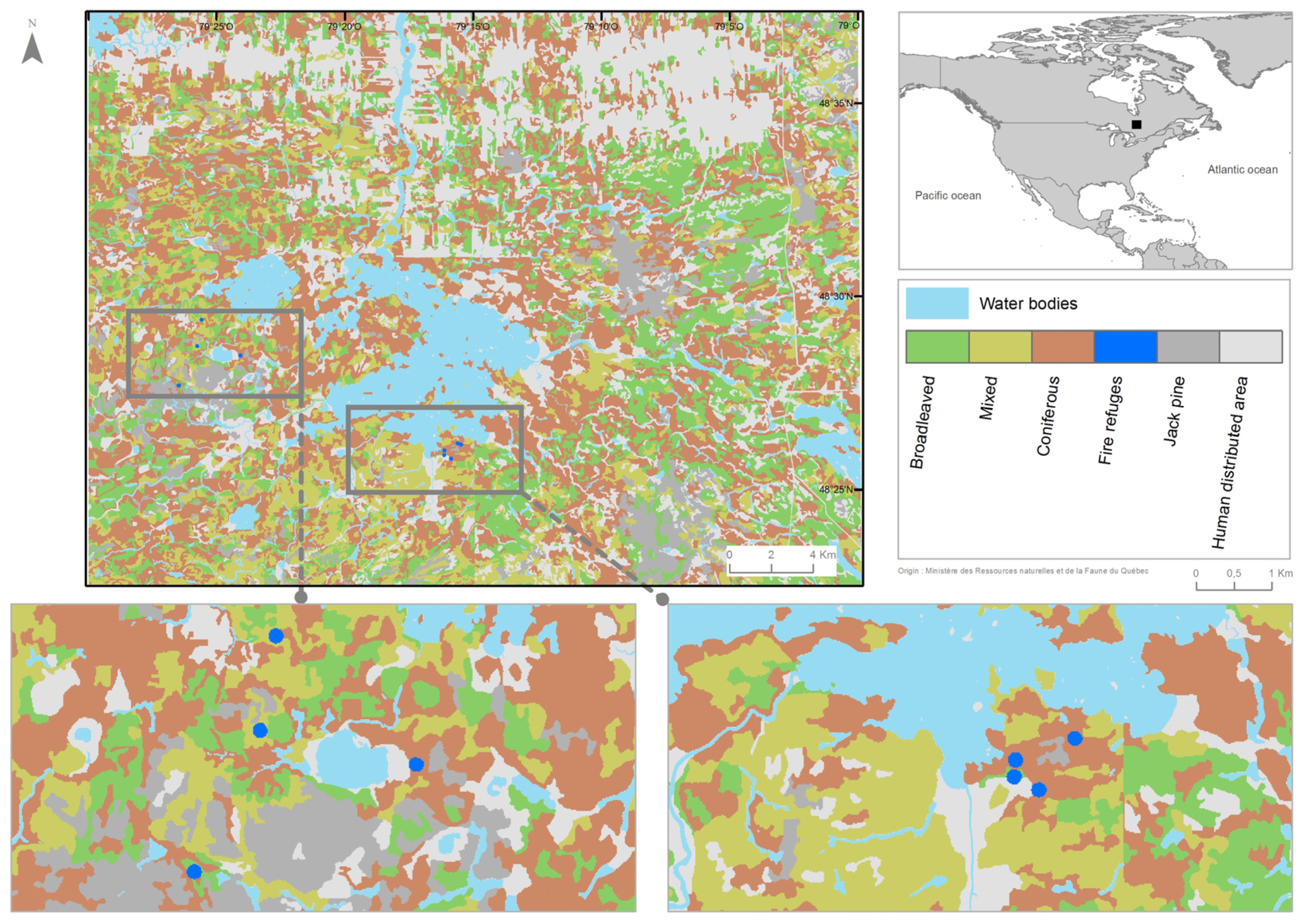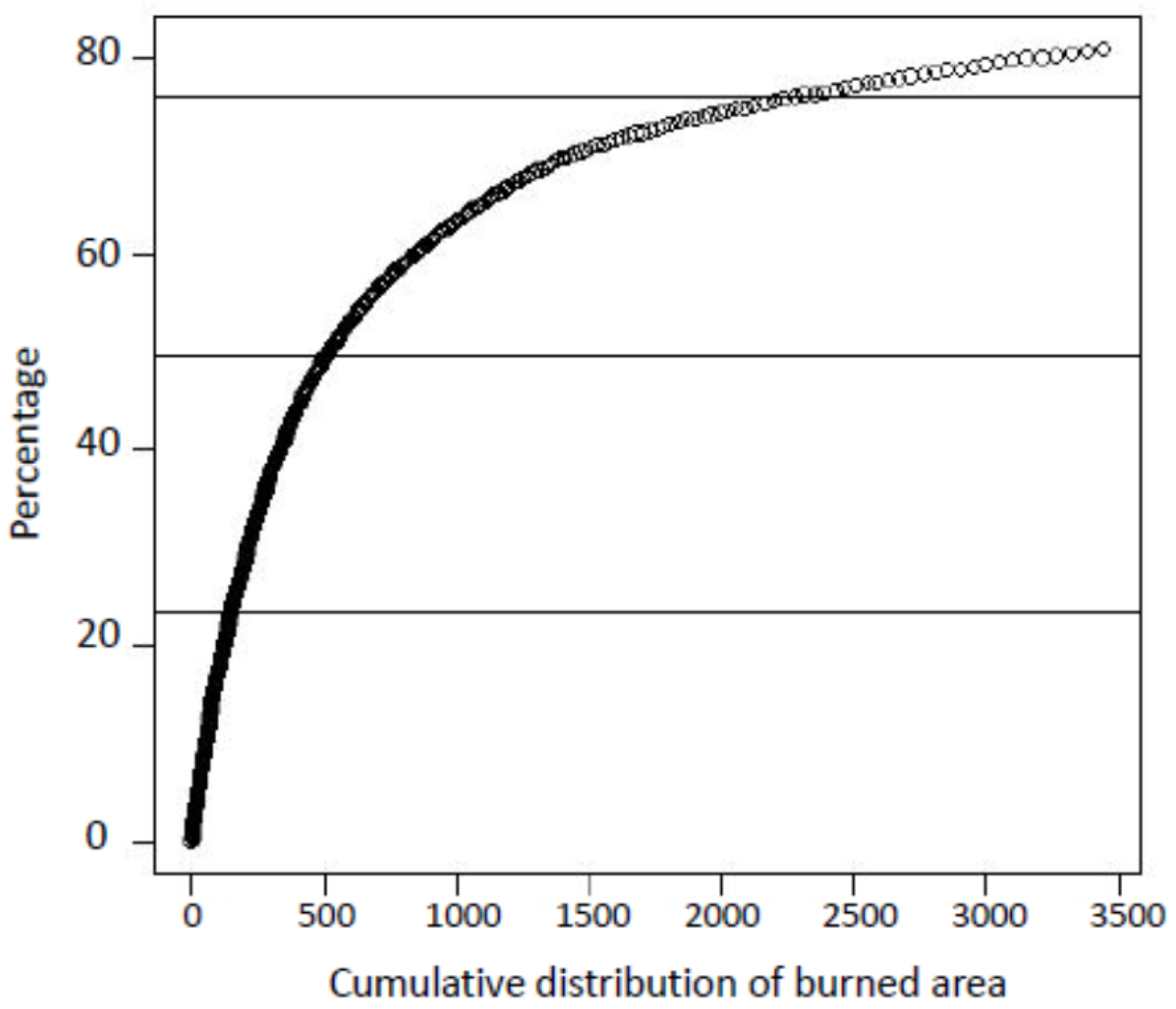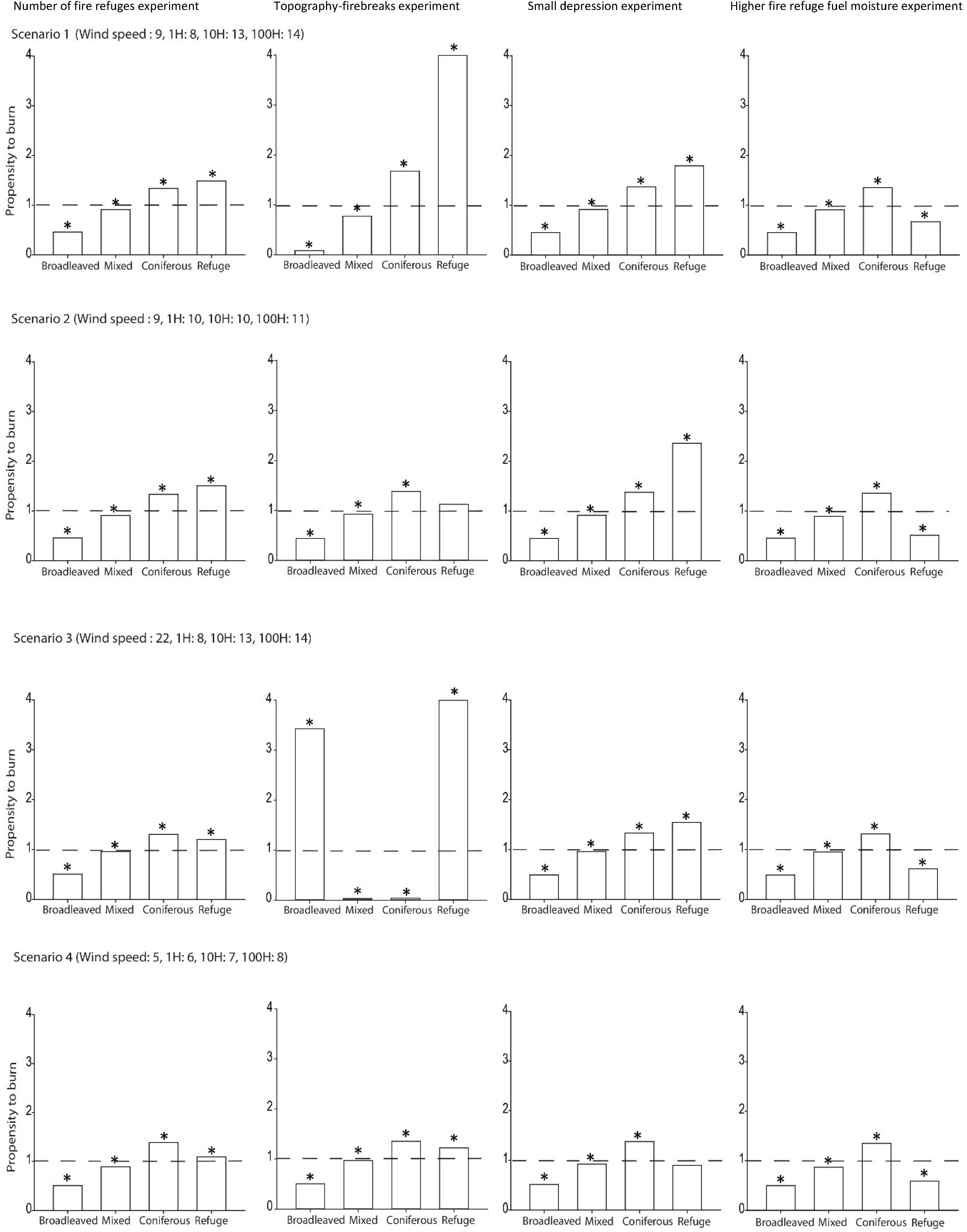1. Introduction
Fire is one of the dominant ecological drivers affecting vegetation patterns and dynamics in the circumboreal region [
1,
2]. Fire effects vary spatially depending on fire behavior [
3,
4] and the fire return interval. A burned area usually includes residual patches that partially or entirely escaped fire [
5,
6,
7,
8]. Two types of post-fire residual patches have been distinguished in eastern North American boreal mixedwood forests [
9]: (1) “transient residual patches” that only escaped the last fire, probably due to peculiar but temporary unsuitable conditions for fire propagation; and (2) “fire refuges” that escaped several consecutive fires, likely due to specific site conditions. Although fire refuges represent a small proportion of the total area burned, they could provide unique habitats in post-fire successional landscapes [
8]. Indeed, the ecological continuity recorded in fire refuges (unlike in transient residual patches, which only escaped the last fire) [
9] could provide refuges for species with specific biodiversity signatures associated with old successional stages [
10,
11] that could be taken into account in biological conservation strategies for boreal ecosystems [
12].
Fire behavior varies spatially depending on fuel features (composition, load, moisture, and spatial arrangement), landscape structure and composition, soil type, topographic constraints, and weather conditions [
3,
4,
13]. Numerous studies have documented the spatial distribution of post-fire residual patches at the landscape scale (e.g., [
14,
15,
16,
17,
18,
19]). They showed that the occurrence of residual patches within burned areas could be related to topography, soil moisture, or wind dynamics during fire, fuel load, or presence of firebreaks. However, the respective roles of these factors likely vary among regions and residual patch types (transient or refuge), but this has never been tested before. Here we propose to evaluate the role of different ecological factors in the occurrence and long-term persistence of fire refuges in the mixedwood boreal forest of northeastern North America. We hypothesized that environmental conditions in fire refuges are less prone to fire activity as compared to the surrounding forest matrix. Therefore, fire refuges were compared with the surrounding forest matrix under different environmental conditions (mainly weather and fuel moisture) to determine if fire refuges have a lower propensity to burn than the other forest cover types present in the landscape.
A non-destructive approach, based on modeling, was selected for estimating the fire susceptibility of fire refuges. Fire refuges are old, conifer-dominated stands (time since the last fire is at least 250 years) within a surrounding matrix (less than 250 years old) of broadleaved, mixed, or coniferous stands. Therefore, a qualitative assessment of stands based only on composition might not allow for the differentiation of refuges from the matrix. Stands were thus quantitatively characterized based on fuel type, fuel load, and tree species composition and structure. We developed an original three-step methodology, based on the combination of three fire behavior models, often used in the North American context. First, we qualitatively characterized stand fuels using the Canadian Fire Behavior Prediction system (hereafter FBP, [
20,
21]), which allowed us to simulate realistic values of fire behavior within stands. Second, we quantitatively calibrated the characterization of stand fuel types and loads using the BehavePlus system [
22,
23]. BehavePlus allowed us to discriminate the different stand types while still predicting realistic fire behavior at the stand level. Finally, we simulated fires and their respective areas burned at the landscape level using the FlamMap3 model [
24,
25]. FlamMap3 is based on the BehavePlus system for fire propagation across pixels and allows computation of burned area probability maps in order to test stand susceptibility to fire.
3. Results
At the end of the parameterization procedure, ROS predicted by the FBP and BehavePlus systems were in good agreement (R2 = 0.8), ranging from 0.2 to 9 m/min. A slight overestimation from BehavePlus in conifer stands was noted, with the heaviest fuel loads under highest fire risk with windy conditions. This satisfactory agreement between both fire behavior models running at the stand level confirmed that the BehavePlus model could be adapted to the boreal mixedwood forest if the fermentation layer (deep litter) was taken into account in fuel load characterization. This adjustment of fuel load yielded more realistic values for all stand types.
While the large number of iterations (10,000 fire ignitions) for each scenario and experiment almost always resulted in rejection of the null hypothesis, we chose to interpret only the most significant signals in stand propensity to burn with a special focus on fire refuge type. We also chose to interpret only the general pattern among stand types in order to evaluate the ecological relevance of the landscape fire model, discarding minor differences which were difficult to interpret from an ecological standpoint.
Simulation comparisons from the first modeling experiment based on actual forest mosaic stand characteristics (location, number, and fuel types) but with set weather/fuel moisture scenarios, showed, for each fire size class, that fire refuges seem to have a high propensity to burn (up to 3.46), except for scenario 4 (
Figure 3). Moreover, the relative propensity to burn of fire refuges seems to be higher than those of any of the other stand types (
Table 5). Between-stand differences decreased with increased fire danger (scenarios 3 and 4) and fire duration.
The fifth modeling experiment (
Figure 4,
Table 6), testing the effect of very moist fuels in fire refuges compared to other stands, was the only experiment that systematically showed significant reduction in fire refuge propensity to burn through all fire danger scenarios (
Figure 4, right panel). The reduction was so strong that the fire refuge propensity to burn shifted to a propensity not to burn (ratio < 1) and fire refuge stands were systematically ranked in third position, just above deciduous stands but below mixed and coniferous stands. For all other modeling experiments, propensity to burn generally increased from broadleaved to coniferous stands, and those from fire refuges were among the highest (
Figure 4, first three columns and
Table 6). Differences in propensity to burn of fire refuges compared to those from their actual locations (second experiment in
Figure 4 versus
Figure 3) were likely due to the random ignition effect.
4. Discussion
Results from the present study are based on a large number of fire behavior simulations at the landscape level, combining different fire sizes and weather/moisture scenarios, and testing different environmental factors possibly explaining the occurrence of fire refuges, a peculiar type of post-fire residual patches [
18,
33,
57,
58]. Moreover, due to the influence of environmental features such as fire severity, location in the landscape, and fuel characteristics, fire refuges, unlike other transient residual patches, are assumed to not be randomly distributed [
59].
Although the large number of fire ignitions almost systematically pushed the statistical interpretation toward rejection of the null hypothesis, we clearly and logically found an increase in propensity to burn from broadleaved to coniferous stands, suggesting that FlamMap3 is an efficient model to study the relationship between vegetation and fire in the mixedwood boreal forest. Our analysis also suggests that stand fire hazard increases through the successional sequence in canopy tree species replacement [
33]. This increase in propensity to burn only results here from differential fuel load accumulation and fuel spatial arrangement (input in FlamMap3) [
27,
33], but not from changes in surface fuel quality (composition) since it has not been directly considered as input in the FlamMap system. The late successional coniferous forest stands accumulate fuels, leading to increased forest combustibility known as build-up [
4,
60,
61]. This trend was confirmed in most simulation results except for three simulations whose patterns could only be explained by the randomness of ignition locations (
Figure 4), which were likely overrepresented in some types (broadleaved, refuges, or even in water bodies and human disturbed areas).
A second logical result from the real forest mosaic composition (i.e., stand proportions) was the effect of weather conditions, which induced a decrease in stand propensity to burn with increasing fire weather risk, as well as with increasing fire duration (i.e., fire size). Indeed, both changes allowed fires to spread more easily and therefore increased the probability to reach many stand types.
Regarding the main objective of the present study, we showed that fire refuges in the eastern Canadian mixedwood boreal forest burned more than the surrounding forest matrix when fuel moisture per fuel type (1 h, 10 h, 100 h, litter, and live fuels, respectively) was held constant throughout the landscape. From this first analysis, it is clear that in their current location, the association of fuel types and loads, topography at ground level, and firebreaks in their vicinity cannot explain the presence of fire refuges nor their spatial distribution in the forest mosaic. This was confirmed by the results of the second experiment with more numerous fire refuges randomly located in the landscape, as fire refuges maintained a higher propensity to burn than the surrounding forest matrix. Hence, fire refuges in the Lake Duparquet area actually present fuel characteristics favorable to fire ignition and fire spread in terms of shape, size, density, loading, chemical properties, and spatial configuration [
62], but not moisture.
Similarly, our results excluded the predominant effects of firebreaks and topography in the occurrence of refuges based on the first, third, and the fourth modeling experiments. This result contrasts with those from previous studies explaining that the spatial occurrence of post-fire residual stands was influenced by firebreaks, such as rock outcrops and water bodies, which disrupt horizontal fuel continuity, thus preventing fire propagation [
3,
17,
18,
55]. Despite the relatively high proportion of water bodies in the study area, their role as firebreaks does not seem to explain the lower propensity to burn of fire refuges. However, this study cannot exclude the effect of firebreaks on other residual patches (transient residual patches) in the landscape [
63]. Indeed, the role of lakes intercepting and stopping fire spread more likely depends on wind direction during fire and on ignition location in the landscape in comparison with residual patches location. The importance of protected topographical positions was also reported as an important factor in interior forests of eastern Washington [
64] and south central Wyoming [
65], where old forests are found. The generally flat topography in our study area as compared to the abovementioned regions likely explains why no link between the occurrence of fire refuges and landforms was found here. Moreover, while we tested for the presence of Holocene small depressions as initial conditions favorable to fire refuge creation, they appeared to have no negative effect on fire behavior and therefore cannot fully explain the occurrence of these persistent unburned stands in the landscape. However, fire refuges burned
less than other stand types (except pure broadleaved stands) when they were assigned higher fuel moisture content in the simulations as observed and measured in the field. Because fire refuges escaped multiple stand-replacing fires that have occurred in the surrounding forest matrix, high fuel moisture appears to be the critical factor reducing fire intensity, as also reported in previous studies [
63,
66]. Moreover, it is worth noting that under past extreme fire weather conditions, even fire refuges sometimes have burned [
9]. Beyond weather condition, fuel moisture is usually related to topography and aspect [
67]. The aspect determines the solar-flux (cool, wet north and east facing aspects) and can impact soil moisture, which has important influences on fire behavior [
48,
68,
69]. In the present study, due to the flat topography, the high moisture content of the litter in fire refuges seems to be rather related to the indirect effect of shallow depressions that have been filled with organic matter though time (centuries to millennia [
9]), in which water tends to accumulate and peat to develop.
While the results of this study seem to be in accordance with palaeoecological analyses performed in situ, comparisons with other studies or regions are difficult. First, differences between fire refuges and other transient residual patches have never been tested before. Second, the role of firebreaks and topography can vary regionally based on the macro- and micro-topography of the study area. Therefore, to understand the general pattern of fire refuge occurrences in a given landscape, more investigations are needed locally to take into account the present day mosaic specificities and potential past changes as revealed by palaeoecological analyses. Hence, given the potential importance of fire refuges in the landscape (biodiversity hot spots [
10,
11]), they should be subjected to special conservation efforts.










